Even with small spaces where there is no room for large gardens or big trees, it is possible to create biophilic experiences that resonate with users’ emotions.
Human reconnection with Nature is one of the greatest challenges of architecture in the attempt to generate more livable cities in built environments. Among architects and designers, there were visionaries who sought to reflect an indivisible relationship between art, life, and nature in their compositions. One of them was Hundertwasser (1928-2000) who opposed straight lines, geometry, and proposed spiral shapes to connect the inhabitants with the natural environment (Rizzo La Malfa, A. 2019).
Hundertwasser said: “Our houses are sick, they lack emotion, they are dictatorial, cold, anonymous, and empty to the point of boredom. A good building must achieve two things: harmony with Nature and harmony with individual human creation”. Many of his constructions with natural but also symbolic elements in Austria and Germany may have inspired designers of vegetated buildings that stand at different latitudes (Fig. 1).
Inspired by these visionaries, biophilic design today goes beyond the presence of vegetation and addresses a complex and multidimensional concept of “Nature” which brings together the material and the sensory as well as the symbolic and spiritual features. More than 40 TNOC contributions have discussed our positive emotional connection with nature in cities, working environments, healthcare facilities, schools, and other urban settings since the year 2013.
According to Kellert (2018), one of the pioneers in biophilic design in architecture, biophilic designs involve an experience of authentic Nature rather than an artificial one with multiple benefits in health, well-being, productivity, biodiversity, and circularity. Kellert and other professionals began exploring how the inclusion of natural features, such as natural light, outdoor views, organic materials, and green space, could improve the quality of life for building occupants. Later, other scientific studies demonstrated that the incorporation of natural elements into built environments could improve physical and mental health, increase productivity and occupant satisfaction, and reduce stress and fatigue.
Since then, different interpretations have emerged, which have contributed to building certifications such as LBC, Well, and LEED.
When studying biophilic elements used in architectural design Browing and Ryan (2020) clustered biophilic attributes into three categories: Nature in Space, Analogous Nature, and Nature of Space.
When designers use patterns from Nature in Space, elements that guarantee contact with Nature such as the presence of plants, animals, and water are most preferred. Generally, from inside the building there is a visual connection with green and blue compositions and, at the same time, climatic comfort and ventilation are guaranteed. When Analogous Nature patterns are applied, design strategies use references or representations of nature that evoke naturalness through materials, textures, colors, and ornamental elements.
Other designers prefer to design for emotions. This means to design environments inspired by preferences in environmental perception (Nature of space). Spatial qualities of natural environments are imitated to evoke or improve human responses. Therefore, it is necessary to conceive spaces that are coherent, legible, and offer an appropriate level of complexity because they are more likely to be perceived as attractive, inviting, and foster wellness. In this case, the theory of environmental preferences of Kaplan and Kaplan (1989) through Risk, Prospecting, and Refuge is being applied. Understanding these preferences can guide the design and management of environments to enhance their quality and user experience.
In Argentina, particularly post-COVID-19, coffee shops and restaurants with biophilic designs have multiplied to attract customers. As stated in a previous article by Diana Wiesner, a landscape architect, and TNOC writer, “the pandemic gives us an opportunity to rethink the ways of planning cities and territories”.
We found the wide range of different perspectives in the designs observed that addressed biophilia in these coffee shops and restaurants very interesting. Therefore, we created a biophilic index to compare their qualities, as a possible aid for future customers or guests making decisions as to where they want to go, as well as the improvements managers may need to make. To create our index, we surveyed 21 cafes and restaurants with multiple existing biophilic designs. We visited, as customers ourselves, a representative sample of cafes and restaurants and scored 65 variables which we clustered under the elements: Earth, Water, Air, Fire, Sounds, Fire, Light, Vegetation, Scent, Animals, Landscapes, Spatial Perceptions, Scale, Color and Food (Fig. 2). As a check-list, the tool proposed was easy to use and allowed us to distinguish between very biophilic, biophilic and somewhat biophilic establishments (Frontera et al. 2023).
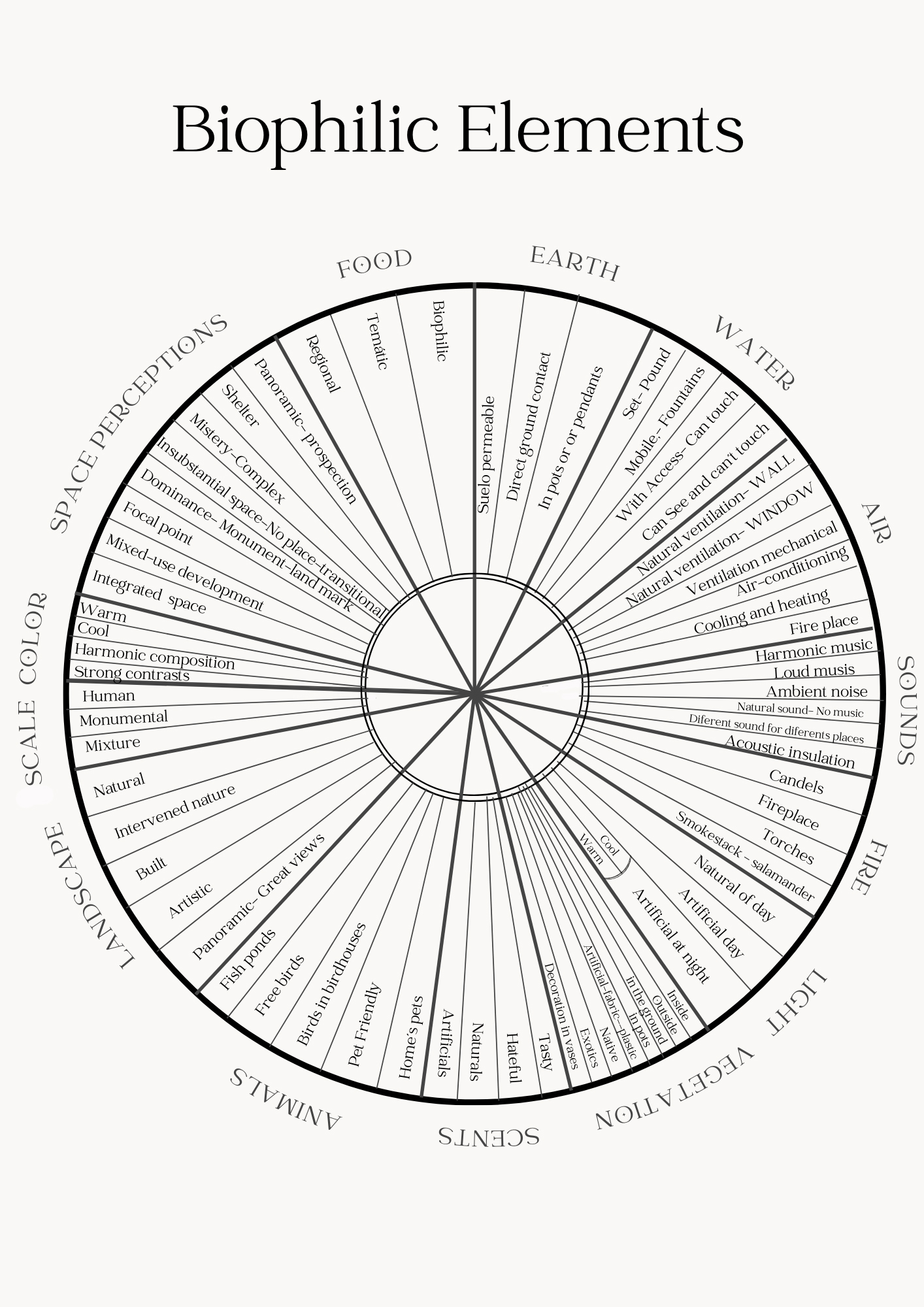
The biophilic design index varied from 170 to 72 out of a possible maximum of 224.
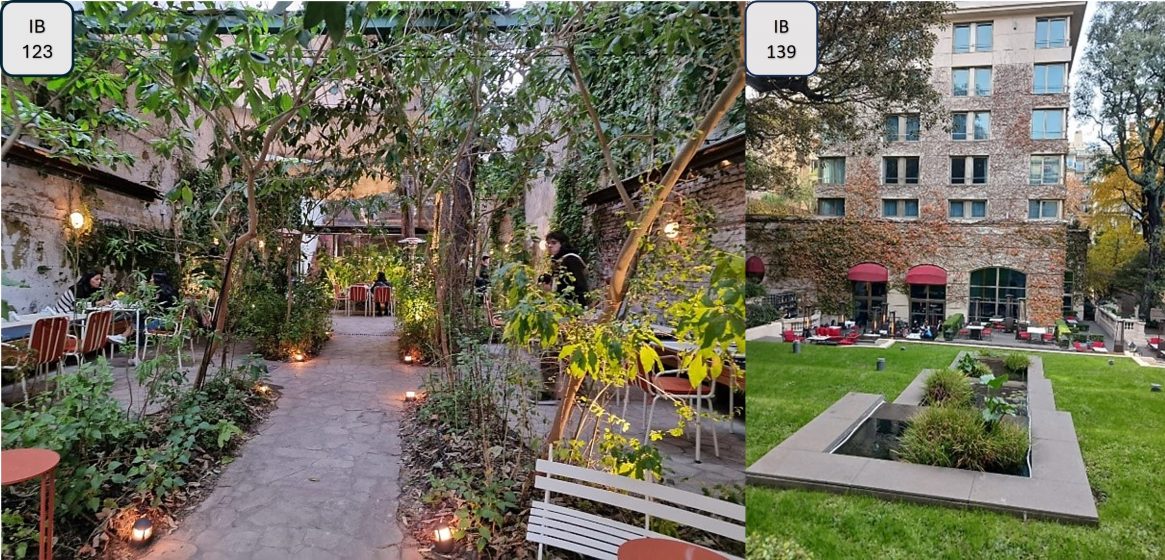
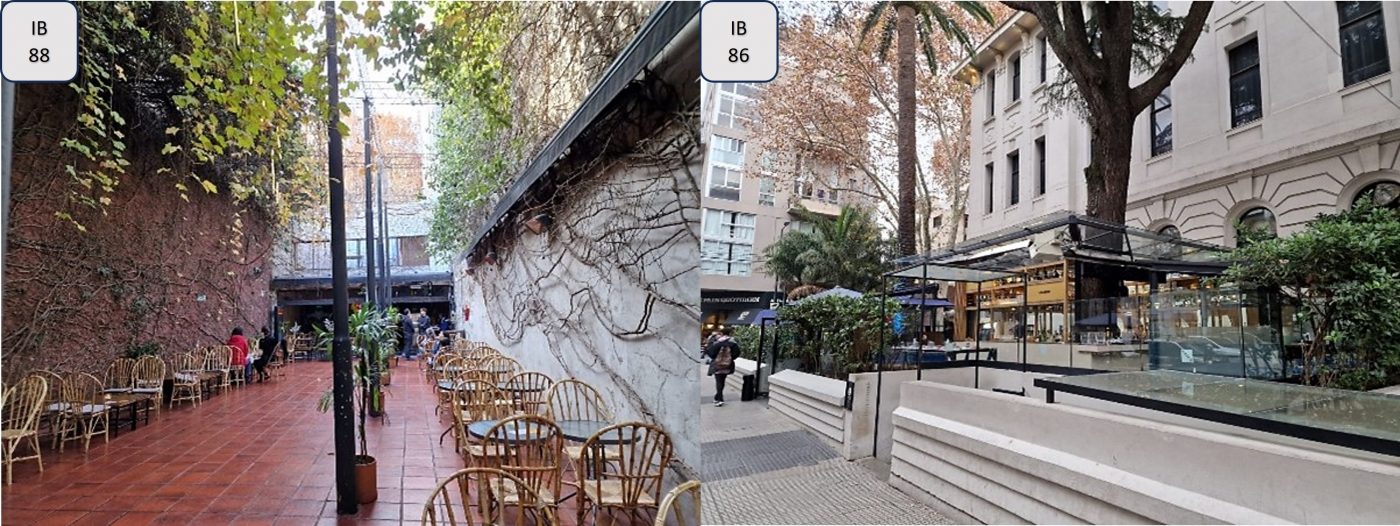
This index reflects a technician’s perspective, which an architect or designer might have when deciding on the project (Fig. 2, 3, and 4). But what would the customers prefer? Of these biophilic compositions, which would be the ones that arouse people’s interest most?
To answer these questions, we collected feedback from users as we reviewed customer´s comments published on the Instagram and Facebook pages of the cafes and restaurants previously studied. We compared the comments of eleven sites with biophilic and very biophilic designs with those of ten sites with somewhat biophilic designs incorporated and considered 623 comments mentioning 961 words that could be related to the biophilic design.
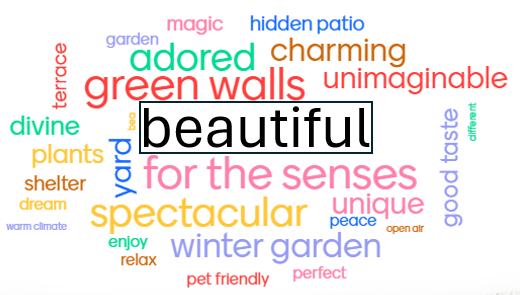
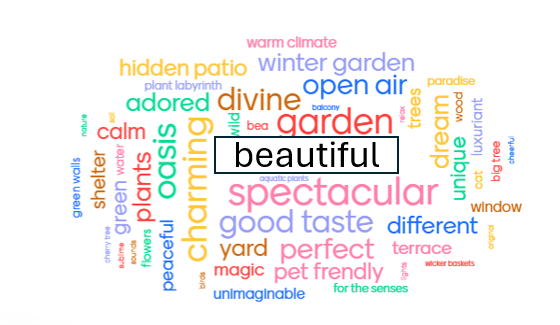
In both groups, the most mentioned words were qualities that had to do with emotions (Fig, 5 and 6). That is, they referred to attributes that correspond to the Nature of Space such as spectacular, beautiful, divine, charming, unimaginable, divine, adored, etc., rather than specific elements of the composition such as plants, green, trees, flowers, water, etc. As expected, the mention of Nature in Space (green, water, flowers) scored in second place in the very biophilic and biophilic places, while artificial design elements that emulated Nature: decor, wicker baskets, green walls, labyrinth, wood, terrace, bay windows, lights (Analogous Nature) were important in the somewhat biophilic sites.
When comparing opinions, the similarity of the comments corresponding to the categories Nature of Space reached 65%, 30% in the case of Nature in Space, and 20% in Analogous Nature.
These results show that the sites that ranked higher were those that best achieved creating experiences that produce a positive emotional response that strengthens the connection between the user and the place. Designers understood customers: the post-pandemic period created the need to be in spacious, open-air, and green places to meet with friends or simply to connect with oneself. Feeling happy, inspired, safe, and/or relaxed were the key feelings they wanted users to experience when interacting with their designs. They managed to create a coherent and meaningful experience with design elements aligned to evoke the desired sensations: the sounds of nature, and blue and green colors to convey calmness and serenity. Also, the design included surprise elements to generate positive emotions and create a memorable experience through hidden patios, terraces, and labyrinths adding value to the user involvement. These conclusions are significant because they show that even with small spaces where there is no room for large gardens or big trees, it is possible to create biophilic experiences that resonate with users’ emotions.
As emotional experiences are subjective and can vary over time, to keep customers and make continuous design improvements, owners of these cafes and restaurants should consider people´s comments, which can be found simply by browsing over their networks.
In a previous TNOC contribution, Jonce Walker, New York City wrote that it is worthy to place what is referred to as smaller biophilic urban acupunctures, in the urban fabric to produce small-scale but socially catalytic interventions. Going out for some coffee or a meal in these environments can help improve people’s moods, connect people to their surroundings, and improve mental health. Urban acupuncture designs can create ideal spaces with positive effects on our daily or weekly activities. Creative interventions without the need for needles ― found when one simply goes out for a cup of coffee!
About the Writer:
Regina Nabhen
Regina Nabhen is magister in Environmental Science, teaches environmental communication at the Flores university.
About the Writer:
Patricia Frontera
Patricia Frontera is Architect and works in urban strategic planning in Buenos Aires.
About the Writer:
Ana Saez
Ana Saez is a sociologist and founder of an environmental NGO “Senderos Ambientales” that offers environmental education workshops.
Ana Faggi, Regina Nabhen, Patricia Frontera, and Ana Saez
Buenos Aires
References
Browning W.D., C.O Ryan (2020). Nature Inside A biophilic design guide RIBA Publishing London https://doi.org/10.4324/9781003033
Frontera, P., Faggi, A., Nabhen, R., A. Saez , (2023) Propuesta metodológica para comparar calidad de diseños biofílicos RADI, AÑO 11 – VOLUMEN 22 | ISSN 2314-0925
Kaplan, R. & S. Kaplan (1989). The Experience of Nature: A Psychological Perspective. Cambridge: Cambridge University Press.
Kellert, S.F., J.H. Heerwagen, & M.L. Mador (2008). Biophilic Design: The Theory, Science & Practice of Bringing Buildings to Life. Hoboken, NJ: John Wiley& Sons.
Rizzo La Malfa, A. (2019) Naturación Urbana: El legado de Friedenreich Hundertwasser. Arkhe 5: 78/85.
Walker, J. The Nature of Cities (2016) https://www.thenatureofcities.com/2016/05/17/biophilic-urban-acupuncture-the-importance-of-biophilia-in-urban-places/
Wiesner D. The Nature of Cities (2020) https://www.thenatureofcities.com/2020/05/03/covid-has-upended-all-the-normal-routines-in-our-lives-and-work-how-do-you-imagine-you-might-be-changed-by-it-both-professionally-but-also-personally-as-you-negotiate-a-new-post-virus-norm/
About the Writer:
Ana Faggi
Ana Faggi graduated in agricultural engineering, and has a Ph.D. in Forest Science, she is currently Dean of the Engineer Faculty (Flores University, Argentina). Her main research interests are in Urban Ecology and Ecological Restoration.


